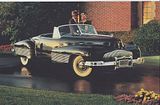The Buick Y-Job was the auto industry's first concept car, produced by Buick (a division of General Motors), in 1938. Built under the direction of General Motors' first design director, Harley Earl, the Y-Job was never intended for production but instead foreshadowed the styling and engineering cues Earl and his team hoped to use on future GM vehicles. In its day, the Y-Job earned praise for its modern style that included power-operated hidden headlamps, a "gunsight" hood ornament, electric windows, wraparound bumpers, flush door handles, no running boards and prefigured styling cues used by Buick until the 1950s. The vertical waterfall grille design still used by Buick today. The positive reaction helped several of its design cues to make it into production, including the stubby tail fins that would appear on the iconic 1948 Cadillacs and the grille design that continues to influence Buick design. Although the Y-Job didn't make production, it remains an example of the good a concept car can do for a company and the industry. We can't help but wonder what would have happened, though, if Buick put the Y-Job into production. The company would have been in an even better position postwar. The car itself was actually driven for a number of years by Harley Earl, until he replaced it with a 1951 model car. Sometime after that, the car was restored at the Henry Ford Museum, until 1993 when it was returned to the GM Design Center. The "Y" in the name has several explanations:
In 2001, Buick recreated the Y-job with modern advancements called the Buick Blackhawk drawing extensively from the Y-job. |
|







